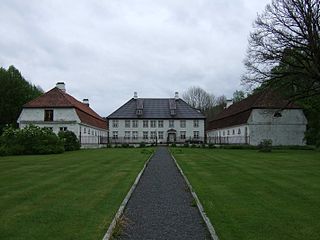
Odda is a former municipality in the old Hordaland county, Norway. The municipality existed from 1913 until its dissolution in 2020 when it was merged into Ullensvang Municipality in Vestland county. It was located in southeastern Hordaland county, surrounding the southern end of the Sørfjorden. The administrative centre was the town of Odda, which was also the main commercial and economic centre of the entire Hardanger region. Other villages in the municipality included Botnen, Eitrheim, Håra, Røldal, Seljestad, Skare, and Tyssedal.

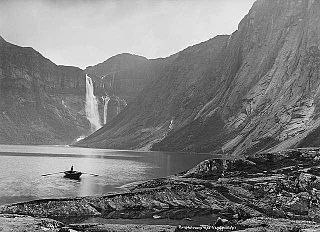
Ringedalsvatnet is a lake in Ullensvang Municipality in Vestland county, Norway. The 7-square-kilometre (2.7 sq mi) lake sits just east of the village of Skjeggedal and about 3.5 kilometres (2.2 mi) east from the village of Tyssedal, which sits on the shore of the Sørfjorden. The lake is the main reservoir for a hydroelectric power station in Tyssedal which provides electricity for the power intensive industries in the nearby town of Odda. The 521-metre (1,709 ft) wide and 33-metre (108 ft) high Ringedals Dam was constructed from 1910–1918.

Karjohansvern at Horten was the main base for the Royal Norwegian Navy from 1850 to 1963.
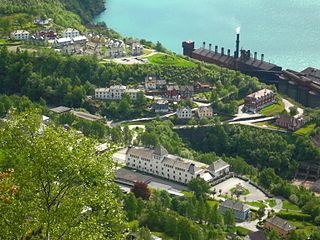
Tyssedal is a village in Ullensvang municipality in Vestland county, Norway. The village is located on the shore of the Sørfjorden about 6 kilometres (3.7 mi) north of the town of Odda. Tyssedal is located in an environment in a valley between the fjord to the west and the mountains leading up to the Hardangervidda mountain plateau to the east.

The Kistefos Wood Pulp Mill is a former pulp mill and hydroelectric power plant in Jevnaker, Norway. It was founded by Kistefos at the river Randselva in 1889.

The Directorate for Cultural Heritage is a government agency responsible for the management of cultural heritage in Norway. Subordinate to the Norwegian Ministry of the Environment, it manages the Cultural Heritage Act of June 9, 1978. The directorate also has responsibilities under the Norwegian Planning and Building Law.

Thorvald Astrup was a Norwegian architect, particularly known for industrial architecture.
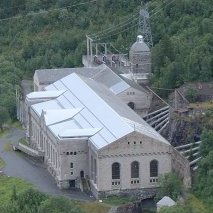
Norwegian Industrial Workers Museum is an industrial museum located at Rjukan in Tinn, Norway. Located in the Vemork power station, it was established in 1988 to allow the preservation of industrial society created by Norsk Hydro when they established themselves in Rjukan in 1907. The museum is an anchor point on the European Route of Industrial Heritage.

Norsk Hydro Rjukan is an industrial facility operated by Norsk Hydro at Rjukan in Tinn, Norway, from 1911 to 1991. The plant manufactured chemicals related to the production of fertilizer, initially potassium nitrate from arc-produced nitric acid and later ammonia, hydrogen, and heavy water. The location was chosen for its vicinity to hydroelectric power plants built in the Måna river.

The Norwegian Museum of Hydropower and Industry is a cultural history museum at Odda in Vestland county, Norway. The museum is located in the village of Tyssedal. The museum is dedicated to the industrial history of Odda and Tyssedal, and more generally to history related to rivers and water, hydropower production, electricity, power intensive industry and its society.

The Norwegian Sawmill Museum is a museum located in the village of Spillum in Namsos Municipality in Trøndelag county, Norway. The town of Namsos lies just to the north, across the river Namsen. The museum opened in 1991 at the site of the former sawmill operated by Spillum Sawmill & Planing.
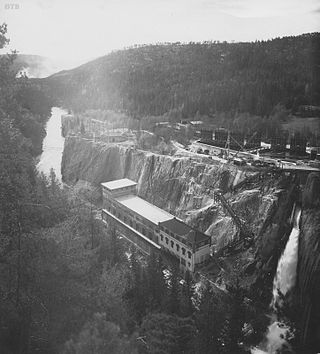
The Svelgfoss Power Station is a hydroelectric power station located at the Tinnelva river in Notodden, Vestfold og Telemark, Norway. It operates at an installed capacity of 92 MW, with an average annual production of about 500 GWh.
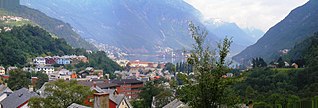
is a town in Ullensvang Municipality in Vestland county, Norway. The town is the administrative centre of the municipality and the largest urban area in the whole Hardanger district. The town is located at the southern end of the Sørfjorden, in a narrow valley between towering mountains and the lake Sandvinvatnet to the south. The large Folgefonna glacier lies just west of Odda, high up in the mountains. The village of Odda was declared a "town" in 2004.
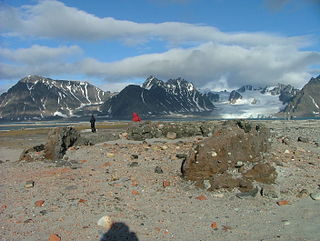
The archaeology of Svalbard is the study of human activity in the northerly Arctic Ocean archipelago's past. The geography, environment and climate of Svalbard have resulted in exceptional preservation conditions. Archaeological fieldwork on Svalbard is both expensive and physically exhausting, but new technology and infrastructure has allowed easier access. This easier access has also resulted in more damage caused by tourists.

The Rjukan–Notodden Industrial Heritage Site is a World Heritage Site in Vestfold & Telemark county, Norway, created to protect the industrial landscape around Lake Heddalsvatnet and Vestfjorddalen valley. The landscape is centered on the plant built by the Norsk Hydro company to produce calcium nitrate fertilizer from atmospheric nitrogen using the Birkeland–Eyde process. The complex also includes hydroelectric power plants, railways, transmission lines, factories, and workers' accommodation and social institutions in the towns of Notodden and Rjukan.

Technical and Industrial Cultural Heritage in Norway encompasses discontinued industrial and other facilities with great historical and architectural value. It is one of the ten conservation programs for the Norwegian Directorate for Cultural Heritage, which seeks to refurbish and preserve a representative range of facilities linked to Norway's most important industrial routes, which has had a significant impact on local business history.

The Textile Industry Museum is a museum in Salhus, Bergen, Norway. It is within the former knitwear factory Salhus Tricotagefabrik, a national industrial heritage site. The museum was founded in 1992, and officially opened in 2001. It focuses on education, documentation of and research into the Norwegian knitwear- and textile industry. In 2020 the factory buildings were protected by The Norwegian Directorate for Cultural Heritage.















